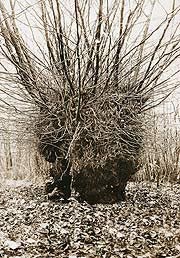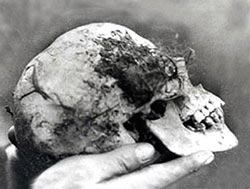
It was a chill spring day in the rural Midlands area of England. Four teenaged boys—Thomas Willetts, Bob Farmer, Fred Payne, and Robert Hart—were poaching in the woods. But when Bob Farmer climbed up an old elm tree in search of birds’ nests, he found something unexpected. The bundle shoved into the hollow tree would rock their small community—and the tremors from that quake would echo for decades to come.
At first, Farmer thought it was an animal’s skull—an opossum, perhaps. But then he noticed the metal fillings in the teeth, the fabric beneath the bones. The boys panicked: they were on the land illegally, after all, and were afraid of being punished for trespassing. They vowed to forget their grisly find and tell no one.
But finding a woman’s body shoved into a dead tree isn’t exactly something you can forget. After hours of turmoil the youngest boy, Tommy Willetts, confessed everything to his father, who immediately contacted the police.
The full details the Worchestershire County Force gathered in the following day cast very little light on the macabre mystery. The coroner thought the woman had been around 35. She had mousy brown hair, and a malformed lower jaw. There was a cheap gold wedding ring, no more than four years old, and she had given birth at least once.
There was also taffeta shoved deep into her mouth, and one hand had been severed and buried at the foot of the tree. The coroner declared cause of death asphyxiation and estimated the time of death to be around October of 1941, a year and a half before her body’s discovery.
For such a small, rural community, the find in the woods was mind-boggling. She couldn’t possibly be a local, where people knew their neighbors going back generations. But what had she been doing in the Hagley Woods? Where had she come from? Who was she?
By Christmas, someone had given her a name. The first message, written in large blocky letters in white chalk, said WHO PUT LUEBELLA DOWN THE WYCH-ELM? In the following weeks, the graffiti changed into WHO PUT BELLA IN THE WYCH ELM?—and so it has remained for over six decades.
Police never discovered who the mysterious writer was, and why they wished to call so much attention to the strange case; but it was widely agreed that the message was consistently written by the same hand. If the graffitist had known something about the woman, he or she never stepped forward to help the investigation, which quickly went cold.

In the months immediately following the discovery, theories began to circulate in local gossip. Professor Margaret Murray of University College in London posited that “Bella’s” death resembled a black magic execution, and suggested witches were responsible. Murray argued that the severed hand was the definitive clue, and cited the “Hand of Glory” practice, where a hand would be severed from a hanged criminal and used for a variety of magical purposes.
And to be sure, the severed hand was an unusual detail. Why would a murderer suffocate a woman, then cut off her hand before shoving her body into a tree and burying the limb amidst the roots? There was no logic behind it, unless one believed Murray’s witch theory.
The next theory to surface was slightly more plausible in the eyes of the police. It was ten years later, and a columnist named Byford-Jones had begun writing a series of articles about the mystery. Not long after the articles ran, a letter arrived for Byford-Jones. A woman, who signed the letter ANNA, Claverly, claimed to have information about the murder.
According to this “Anna”, Bella was actually a foreign spy who had been part of a ring scouting out munitions factories in the area and reporting back to the Luftwaffe. Bella was Dutch, Anna claimed, and had accidentally learned too much about a British officer who was a mole involved in the spy ring. In order to guarantee her silence, the officer and another spy killed Bella before dumping her body in the woods.
The letter even went so far as to name the officer, but further investigation revealed that he had died in a mental ward in 1942, mere months after Bella’s murder. Still, some of Anna’s facts were verified by MI5, and another writer investigating the situation later published a book claiming that a Dutch spy named Johannes Dronkers—who was executed by the British in 1942—had a wife named Clarabella who was in her 30s and had unusual teeth. A wife who had disappeared prior to his capture . . .
When all of this came to light, the public became convinced that Bella had either been a spy or mixed up with spies. And when it emerged that her skeleton had disappeared from the Birmingham University Medical School, an outcry of conspiracy and cover-up began.
There were other theories, of course: that Bella was a prostitute who had picked up the wrong john, that she had been a refugee fleeing the Blitz and had met a rapist in the woods, that she was a gypsy murdered by her tribe for some horrible misdeed. But for the people around Hagley Woods, the first two theories still held the most weight.
Was Bella a witch, or a sacrifice in a black magic ceremony? Was she a spy working for the Germans, or simply someone who had learned too much about them?
The case is still open, though it has long since gone cold. With the body missing and over six decades between the murder and today, the only thing that is clear is that the chances of anyone uncovering Bella’s true identity and that of her murderer are so slim as to be impossible. Just as we may never be sure of Jack the Ripper’s identity, so too will Bella become a figure of myth and folklore.
But perhaps someone still knows something. Last year, the graffiti appeared again after years of nothing. WHO PUT BELLA IN THE WYCH ELM? was scrawled across a 200-year-old obelisk on the Hagley Estate. It could be nothing—the work of teenaged pranksters.
The question, though, continues to haunt.
Angie Barry wrote her thesis on the socio-political commentary in zombie films. Meeting George Romero is high on her bucket list, and she has spent hours putting together her zombie apocalypse survival plan. She also writes horror and fantasy in her spare time, and watches far too much Doctor Who. You can find her at Livejournal.com under the handle “zombres.”
Read all posts by Angie Barry at Criminal Element.

Such a horrifying, fascinating crime.
Her body is in the well at Rosemary Cottage, Pedmore lane which is where bella used to live.